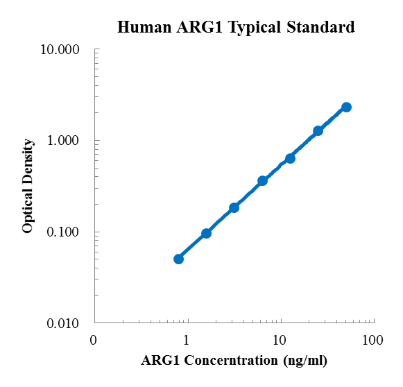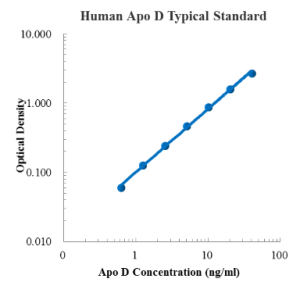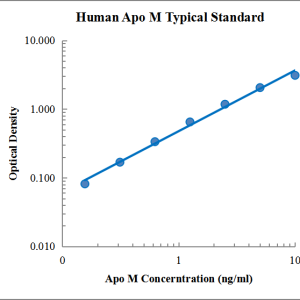Human Arginase 1/ARG1 ELISA Kit
$299.00 – $419.00
ELISA Kit Detail Information
| Related Target | |
|---|---|
| Species | human |
| Sample Type | Serum, plasma, cell culture supernatant, and other biological samples |
| Sample Volume | 50 μL |
| Sensitivity | 26.80 pg/mL |
| Array Range | 0.78 ng/mL – 50 ng/mL |
| Assay Time | 3.5 h |
| Recovery | 75% – 124% |
| Average Recovery | 102% |
| Intra Precision | 3.4% – 4.6% |
| Inter Precision | 2.6% – 4.8% |
| Plate | Detachable 96-well plate |
| Storage | If the reagent kit is unopened, it should be stored at 4℃. However, if it has been opened, the standard solution should be stored at -20℃, while the other components should be stored at 4℃. |
| Delivery | 4℃ blue ice transportation |
| Components | 96-well polystyrene enzyme-linked immunosorbent assay (ELISA) plate coated with anti-ARG1 monoclonal antibody Human ARG1 freeze-dried standard Angiotensinogen/AGT/ SerpinA8 detect Antibody Standard Diluent Assay Buffer(10×) Substrate TMB Stop Solution Washing Buffer(20×) Sealing Film |
| Assay Principle | This kit utilizes the double antibody sandwich enzyme-linked immunosorbent assay (ELISA) detection technique.Specific anti-human ARG1 antibodies are precoated on a high-affinity ELISA plate. Standard samples, test samples, and biotinylated detection antibodies are added to the wells of the ELISA plate. After incubation, ARG1 present in the samples binds to the solid-phase antibodies and the detection antibodies. After washing to remove unbound substances, streptavidin-HRP labeled with horseradish peroxidase is added. After washing, a colorimetric substrate, TMB, is added and the plate is incubated in the dark for color development. The intensity of the color reaction is directly proportional to the concentration of ARG1 in the samples.A stop solution is added to terminate the reaction, and the absorbance value is measured at a wavelength of 450 nm (with a reference wavelength range of 570-630 nm). |
Related Targets
ARG1
ARG1 Target Infomation Overview
- Target Symbol: ARG1, arginase 1
- Alias Names: arginase-1; arginase, liver
ARG1, arginase 1 Target Infomation by Species
- Human
- Mouse
- Rat
Human ARG1 Target Information
- Target Symbol: ARG1, arginase 1
- Alias:
- arginase-1
- arginase, liver
- liver-type arginase
- type I arginase
- NCBI_Gene: 383
- UniProtKB: P05089
Human ARG1 Predicted Functions
Predicted to enable arginase activity and manganese ion binding activity. Involved in negative regulation of T cell proliferation; negative regulation of interferon-gamma-mediated signaling pathway; and positive regulation of neutrophil mediated killing of fungus. Located in extracellular space. Implicated in asthma; hepatocellular carcinoma; and hyperargininemia. Biomarker of asthma and colitis.
Mouse Arg1 Target Information
- Target Symbol: Arg1, arginase, liver
- Alias:
- AI
- AI256583
- Arg-1
- expressed sequence AI256583
- PGIF
- NCBI_Gene: 11846
Mouse Arg1 Predicted Functions
Enables arginase activity. Involved in defense response to protozoan; negative regulation of T-helper 2 cell cytokine production; and negative regulation of activated T cell proliferation. Predicted to be located in several cellular components, including extracellular space; mitochondrial outer membrane; and neuronal cell body. Predicted to be active in cytosol. Is expressed in several structures, including alimentary system; central nervous system; genitourinary system; integumental system; and sensory organ. Used to study hyperargininemia. Human ortholog(s) of this gene implicated in asthma; hepatocellular carcinoma; and hyperargininemia. Orthologous to human ARG1 (arginase 1).
Rat Arg1 Target Information
- Target Symbol: Arg1, arginase 1
- Alias:
- AI type I arginase
- AI, type I arginase
- arginase 1 liver
- Arginase 1, liver
- arginase-1
- arginase, liver
- liver-type arginase
- type I arginase
- NCBI_Gene: 29221
- UniProtKB: P07824
Rat Arg1 Predicted Functions
Enables arginase activity; identical protein binding activity; and manganese ion binding activity. Involved in several processes, including cellular response to hormone stimulus; gland development; and response to vitamin. Located in several cellular components, including extracellular space; mitochondrial outer membrane; and neuronal cell body. Used to study acute necrotizing pancreatitis and hypertension. Biomarker of several diseases, including acute kidney failure; cholestasis; silicosis; ureteral obstruction; and uveitis. Human ortholog(s) of this gene implicated in asthma; hepatocellular carcinoma; and hyperargininemia. Orthologous to human ARG1 (arginase 1).














Reviews
There are no reviews yet.